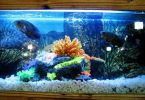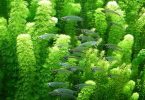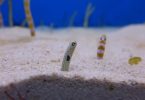Table of Contents
Black Beard algae belongs to the group or species of red algae yet it is not naturally red in colour. The colour of the black beard algae ranges from deep black, to grey, and to dark green.
Also known as the brush algae, (Audouinella, Rhodochorton) the black beard algae becomes reddish when you put it in alcohol. This however is a proof that the black beard algae is of the red algae family.
Black beard algae or brush algae like its name has a beard like or brush like tuft, hence the reason for its name.
Brush algae usually sticks very firmly to the places they grow on, whether they be aquarium decorations, rock, flower petals, substrate grains, bog woods, or even on the ground; they are always stuck there just like parasites.
In this article, we will be telling you all you need to know about the Black beard algae or the Brush algae, first things first, know that black beard algae is an unwanted organism in an unwanted place just like the weed (unwanted plant in an unwanted place).
Causes of Black Beard Algae
Everything that happens is prompted by either a remote cause, or a proximate cause. The case does not change with humans not organisms, especially the black beard algae which is our focus in this article.
So in this section, we will share some of the causes of the black beard algae and in subsequent sections, we will share how to get rid of the black beard algae.
Some of the causes of the black beard algae are actions or series of incidents that cannot be avoided while keep an aquarium and they include the following:
- Too much light
- Extreme organic water pollution
- Imbalance of micronutrients
- Carbon dioxide
1. Too Much Light
Light is always very important and useful as it brings balance to the ecosystem.
Living organisms need sunlight to survive. For instance, plants need sunlight to germinate, grow, and bear fruits till harvest time. Animals and humans too though.
Aquariums or aquatic tanks, and wet lands or ponds necessarily need light for nourishment. Although the sunlight does not have to be in excess hence sometimes the aquarium or aquatic tank is covered to be shielded from too many direct sunlight.
In like manner, wetlands or ponds whether they are artificial or natural also need to be shaded from the direct heat of the sun sometimes which is why plants for ponds are used, and sometimes ponds are put under trees.
In some cases of natural wetlands, a tree could be planted in the area to serve as shade to the pond depending on what the owner of the pond wants.
An organism like the Blackbeard algae is not different from other organisms or any of the living things stated earlier and so, is capable of receiving sunlight as well as utilizing sunlight which the science of photosynthesis clearly explains.
This accounts for how too much light can make an aquarium or an aquatic tank very conducive for the black beard algae or brush algae to grow in.
2. Extreme organic water pollution
Pollution is basically the contamination of an environment especially in a way that makes the environment unhealthy for those in it as well as unhealthy for itself in itself.
Remember that aquariums are aquatic and so are kept in aquatic tanks where they are cared for and fed as well.
The neat aquatic tank is often contaminated when the food is introduced to the aquarium in the aquatic tank. It is worse if the food happens to be an algae which some aquariums snack on sometimes.
The reason this pollution is regarded as extreme or high, as well as raw or organic, is because feed must be introduced to the aquarium even in the aquatic tank, and the feed, though healthy for the aquarium, gives the black beard algae room to grow.
Unfortunately, like most parasitic organisms, the black beard algae or the brush algae multiplies rapidly and other plant organisms including the aquatic tank gets affected.
This is however an extreme cause of the existence of black beard algae which can also be infectious to aquariums.
3. Imbalance of micronutrients
Micronutrients are the most needed nutrients for organisms to survive.
Just like a balanced diet or an adequate diet is needed for humans to be healthy and not look malnourished or even internally unhealthy or malnourished, so are the micronutrients too.
Think about some of the deficiencies that accompany poor feeding, imbalanced diets, or the results and gross adverse effects of not eating right, think about all the diseases that one could be prune to for not eating right.
For a clearer mental picture, did you ever plant a bean seedling in a tin or container (nursery planting) for a school project?
Did you see how it gradually withered away after it was submitted because it could not get all the nutrients it required and no one took care of it?
Again think about how the doctors reprimand patients for over feeding or taking too much sugar.
These two instances are important because you do not have over feed or under feed, feeding has to be done moderately.
Good! That is how it is with the imbalance of micronutrients. Now with aquariums or aquaria, the element this is mostly traced to is the iron.
Giving too much iron to the aquarium could result in the growth of the black beard algae, however the deficiency of iron will also affect the plant or the animal in the aquarium and result in malnutrition.
However if you notice a black beard algae in your aquarium, and also notice a deficiency in your aquarium or aquaria, and you have been feeding your aquarium elements of iron, you will have to change the iron element you feed your aquarium, as well as the mode of feeding your aquarium the elements of iron by adding iron directly without traces of elements
4. Carbon dioxide
Aquarists have discovered that the presence of the carbon dioxide (CO2) in the water is very vital and so it plays a necessary role which can suppress the presence or the appearance of a red algae just like the brush algae or the black beard algae.
If you are very conversant with your elements and human respiration, you will know and remember that humans take in oxygen and give out carbon dioxide, while plants and animals utilize carbon dioxide as well as oxygen for digestion.
Biologists and respiratory experts have a better interpretation of this because they have a full understanding of it.
Now the case is not different with the aquarium which is why we established earlier the facts that surround the presence of carbon dioxide in an aquarium and how it attracts the black beard algae to the aquarium.
However, if there is a carbon dioxide deficiency in the aquarium especially when the black beard algae is already present, the brush algae adaptably takes in the carbon dioxide it needs through the hydrogen carbonate, and it accomplishes this more easily than a variety of aquatic plants; including higher water plants.
More so, the carbon can be separated from the hydrogen carbonate ion, which will in turn produce hydroxide ions, and then increase the alkaline level (pH).
In a process like this, what is called biogenic decalcification occurs, and the limescale (calcium carbonate) expedites, which is later utilized by the black beard algae to rebuild its cell walls.
Gradually this becomes a shield to them because they seem harder, and over time are not appealing to other aquatic organisms in the tank to feed on algae. This also multiplies the black beard algae.
Also these are more dominant in aquarius or aquatic tanks that are used for only fishes, and have lots of food deposited in them.
How to Treat any aquarium affected or infected by the Black Beard Algae
Apart from giving a first aid treatment, or a temporary treatment or relief for a challenge, before actual treatment is carried out, or the solution to a problem is found, there is first an identification of the problem, and then a trace of the problem.
So to deal with the black beard algae or the brush algae in aquatic tanks and aquariums in general, knowing the cause of the black beard algae is the first step to combating it, which is why we carefully outlined some of the causes or factors that promote the production of the black beard algae, have also dutifully announced it.
Having established some of these causes, I will in this session share with us some of the measures that can be implored to control the growth and rapid reproduction of the black beard algae.
Some of the measures that can be taken to control the black beard algae or the brush algae, or to combat the black beard algae, which is usually more difficult than the other species of algae from your aquarium include the following:
- Cut it off
- Use hydrogen peroxide
- Eliminate the appearance of phosphate from your water or your aquatic tank
- Test your source of water
- Boil with warm water
1. Cut it off
This is almost like an ultimatum, especially if you have plants for ponds that have been infested by the black beard algae in your aquarium.
Here is what you should do:
- Carefully examine the plants for ponds in your aquarium
- Separate the infested plants from the healthy plants. Also separate the decorative ornaments if they also have the black beard algae on them.
- Now using a clean garden pair of scissors, thoroughly cut off all affected parts of plants. Very important! If an entire plant is affected, throw it away completely. Sterilize the scissors as well
- Clean up the rest of the plants and ornaments
- Clean up any other tank mates. Note: you can check this article on how to properly clean a fish tank.
2. The use of hydrogen peroxide
The hydrogen peroxide is also used to treat fungal infestations, and is also used for different purposes.
Apart from cutting the plants off, It is also important to use the hydrogen peroxide.
This does not mean you should pour the chemical into the tank or that you should empty the tank and all the tank mates into a bowl or a jar of hydrogen peroxide.
Here is how you can use the hydrogen peroxide to get read of the black beard algae:
- Understand the nature of the plant. This means that before you use the hydrogen peroxide you need to know the nature of the plant, how sensitive can the plant be? Is it a weak plant? Is it a strong plant?
- Dilute the hydrogen peroxide with water little water depending on the nature of the plant. If it is a weak plant then you have to dilute the hydrogen peroxide more than you would have ordinarily for the stronger plant. The reason you should dilute it is so that the plant does not die off. Dip the plants into the solution till the black beard algae is gone
- Soak all ornaments and decors, including plastic plants in the bleach solution or the hydrogen peroxide. After these is done clean up your aquarium tank and put the tank mates back inside the tank.
3. Eliminate the appearance of phosphate (PO4) from your water or your aquatic tank:
It is necessary to first understand what phosphate is before launching into this particular control measure or treatment advise for aquarists.
Phosphate is a byproduct of organisms or things that decay in the aquatic tank. These decaying organisms are not far fetched hence they include left over feeds that come from over feeding the living organisms in the aquatic tanks or best put from over feeding the aquatic tank mates, waste from fish or other aquatic animals, whithered plants and even an algae decay( whether the black beard algae or any other species of algae).
When these things are not cleaned up from the aquarium or the aquatic tank, they decay in water just like they will decay on land, and one the things that emits from the decay is phosphate. Which explains why phosphate is a byproduct of such things or organisms as the case may be.
Furthermore, aquarium salts, hydrogen ion buffer solutions (pH buffers), kH buffer solutions, and carbon filter media can also be used to spike phosphate. Caution has to be applied while using them.
To eliminate phosphate, you can also introduce fast growing and fast feeding fishes in your tanks. Such fishes do away with left overs and clean up the aquatic tank because they eat a lot.
You should also avoid over feeding your aquarium. Feed them in small bits at a time, that way they are able to leave little or nothing as left over.
Also change their foods sometimes, this is very important especially before adding new feeds, change the old unfinished feed because chances are that they will scout and float after fresh feeds.
If you need to eliminate the black beard algae, then you will also need to eliminate phosphate.
4. Test the source of your water
Water is a carrier of so many things just like blood, which is why it is always safe to test the water you supply in your aquatic tank from its source.
Water could be contaminated and hence be a Carrier of the black beard algae which is why it is important that you test the source of the water you intend to supply your aquarium.
What you should also test for in the water apart from the black beard algae, is for the phosphate (PO4) which the preceding sun theme already treated.
If a source is contaminated, then without a second thought, change the source. You can get experts to treat the contaminated water afterwards.
5. Boil with warm water
The health benefits of a hot water or a warm water cannot be over emphasized and should not be underestimated.
To do this you just have to change the water and boil the tank mates and the ornaments in water. Make sure to separate affected mates from the unaffected mates.
Conclusion
The black beard algae is not a very easy species of algae to deal with but a few more tips can help conquer the black beard algae.
For example, think about how neat the aquarium or the aquatic tanks will be if they were cleaned daily, or better put if cleaning and maintaining it were to be a routine activity.
Of course the tank will be free of the particles and factors or conditions that facilitates the growth and the black beard algae.
More so, remember that the black beard algae attacks ponds and aquatic tanks a lot, whether they are natural or artificial so cleaning up the tanks and ponds, and mates, and ornamental decorations should be a hallmark.







